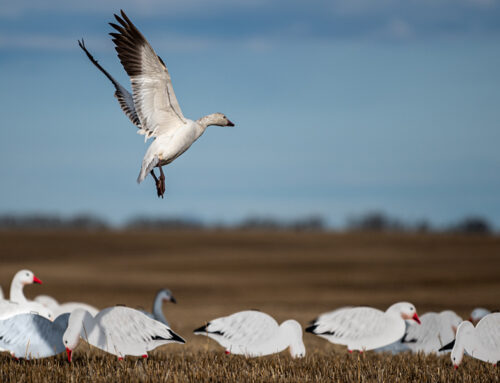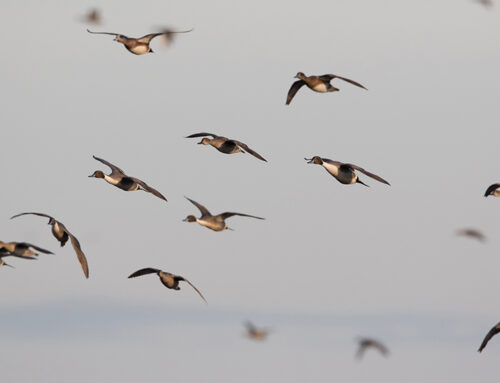Make Your Own Duck Hunting Honeyhole

By John N. Felsher
A swirling black cloud appeared over the horizon above the seemingly endless grass. Soon, the swarm broke into numerous black specters. Before long, we recognized the fast-beating wings of teal heading directly for us at high speed.
 No, we weren’t hunting a vast coastal marsh, but rather a little duck paradise that didn’t even exist a few months prior. We crouched in thick reeds to hide from incoming ducks that morning, but a year earlier, cows grazed in the dry pasture. Then, the landowner decided to create a moist-soil unit — a field periodically flooded and dried to create waterfowl habitat.
No, we weren’t hunting a vast coastal marsh, but rather a little duck paradise that didn’t even exist a few months prior. We crouched in thick reeds to hide from incoming ducks that morning, but a year earlier, cows grazed in the dry pasture. Then, the landowner decided to create a moist-soil unit — a field periodically flooded and dried to create waterfowl habitat.
“People can take any pasture and turn it into a duck pond, assuming they have a good water supply,” explained Lance Stancik of Garwood, Texas. “Water is the key. People only banking on rain will have some years when they don’t have any water in the pond. A well-managed moist-soil unit attracts all types of ducks.”
Typically, a land manager builds levees around fields to create impoundments. In the spring, the manager drains the impoundments and plants corn, milo, wheat, millet or other grains that ducks eat. Once dry, the ground often naturally sprouts various native plants that produce duck food. In late summer, the landowner floods the fields, leaving crops inundated, but intact. Dabbling ducks tip up to feed and prefer shallow water. A teal might only need three or four inches, just enough water to land.
“Ducks need a variety of food sources,” advised guide Larry Robinson. “In a moist-soil unit, people need to be able to show the birds at least 30 to 40 percent open water in order to get those birds interested in coming down to that impoundment.”
 A moist-soil unit is hunted very similarly to a marsh, meaning waterfowlers can see birds coming from long distances. Of course, that also means birds can see hunters from even longer distances. Many waterfowlers plant long-stemmed, leafy plants such as corn around pond edges. These plants add nourishment for the birds and create excellent cover to help hide hunters and blinds.
A moist-soil unit is hunted very similarly to a marsh, meaning waterfowlers can see birds coming from long distances. Of course, that also means birds can see hunters from even longer distances. Many waterfowlers plant long-stemmed, leafy plants such as corn around pond edges. These plants add nourishment for the birds and create excellent cover to help hide hunters and blinds.
Hunting such open country, sportsmen must take extra care to conceal themselves and anything else that looks out of place. Many field hunters dig pit blinds in low levees surrounding a hunting pond. They sink them down almost to ground level and surround them with vegetation.
Most waterfowlers take great pride in hiding themselves from the perspective of something looking at human eye-level. However, they forget to consider the viewpoint of a duck flying overhead. To creatures with such keen vision as ducks and geese, anything that appears unnatural are neon warning signs. Many pit blinds come with lids or partial roofs that help hide hunters from flying birds. If not, throw some netting, cane leaves or brush over the top.
In addition, many hunters reach their field blinds in all-terrain vehicles, unload their gear and park the vehicle some distance away. However, most forget about the ATV tracks. From the air, muddy four-wheeler ruts, even when under shallow water, look like a superhighway pointing to the blind. See for yourself by viewing aerial drone footage of ATV tracks through decoy spreads online.
 “When hunting an open field, we put a lot of emphasis on being hidden with our blinds,” said guide Mike Bogy of Wabbaseka, Arkansas. “The better someone can hide and use decoys, the more ducks that person will kill.”
“When hunting an open field, we put a lot of emphasis on being hidden with our blinds,” said guide Mike Bogy of Wabbaseka, Arkansas. “The better someone can hide and use decoys, the more ducks that person will kill.”
Before putting out the decoys, repeatedly zigzag back and forth across the pond bottom with the ATV, making so many tracks that the telltale path to the blind is obliterated. This also muddies the water, which can hide tracks, decoy lines and anchors. In addition, the stained water simulates mud stirred up by feeding birds.
Most moist-soil units attract multiple duck species. Place decoys in family clusters, held in place by the shortest lines possible in the shallow waters. Since geese also love fields and frequently land on dry ground, place a few goose decoys along the shorelines or on mudflats.
“We change the decoys every day to give the birds a fresh look for each hunt,” Bogy recommended. “People think of mallards when hunting in Arkansas, but we get a good variety of birds. We kill many mallards, but we also get many pintails, wigeon, gadwalls, green-winged teal and other ducks. We even kill some specklebelly geese.”
Many companies make highly realistic decoys. However, nothing looks better than a real bird. When hunting fields pockmarked by grain stubble and weeds, consider using early kills for decoys. Prop up dead birds with sticks or grass clumps in lifelike positions. Wind rippling the feathers completes the deception.
 To add more motion in a static spread, plenty of waterfowlers use mechanical decoys where legal. In flat, open country like a flooded field, birds can spot spinning-wings decoys from incredible distances. Ducks land into the wind, so point spinners toward the breeze. Also, never put spinners directly in front of a blind — put them off to the side so birds focus their eyes away from you.
To add more motion in a static spread, plenty of waterfowlers use mechanical decoys where legal. In flat, open country like a flooded field, birds can spot spinning-wings decoys from incredible distances. Ducks land into the wind, so point spinners toward the breeze. Also, never put spinners directly in front of a blind — put them off to the side so birds focus their eyes away from you.
“Spinning-wing decoys work best on cold, bluebird days after a front passes,” said Terry Denmon of MOJO Outdoors. “On a cold, clear day, a duck can see the flash for more than 10 miles. Birds are gregarious and attracted to that flash. Ducks come to them and land right on top of them.”
Another tactic for adding motion is to dig a hole in the shallow impoundment, position a trolling motor lower unit inside it, and place several linked decoys nearby. Hide the power cord in the mud and run it into the blind. When birds approach, the flip of a switch engages the propeller, causing the decoys to tip over as if grabbing grain off the bottom. It also causes considerable ripples that run across the pond surface, further simulating feeding ducks.
“Putting movement in the decoy spread is essential to convince ducks to land,” advised Jacob Sartain, who develops hunting properties in Madison, Mississippi. “Ducks can fly by motionless decoys and figure out pretty quickly that they are not alive.”
Where laws prohibit mechanical decoys, waterfowlers can resort to old tricks to add realistic movement to decoys. A jerk-cord rig consists of one or more decoys anchored to the bottom and tied to a string stretching back to the blind. Pulling the string makes the decoys bob up and down with lifelike movement.
Not everyone lives close to a coastal marsh or bay, but practically any waterfowler with access to a farm or ranch can turn pastures into outstanding duck ponds. Building and hunting moist-soil units offers many challenges, but your efforts can be rewarded with heavy, diverse bags of ducks and geese.




Better make sure that driving an ATV around to hide tracks/muddy up the water doesn’t involve knocking down any planted ag crops such as corn or millet – if so it creates a classic baiting situation.
I believe this is baiting and should not happen. natural plants or harvested plants but not crops to bait wildlife
So if I plant corn or millet I’m baiting? I think you need to check your laws
A bit crazy this duck hunting method!
I agree with Blane this is baiting and when you add pumps circulating water to keep from freezing it is even more of a manipulation.
I have friends that own and hunt rice fields. If they don’t harvest then buffalo in the rice they get a ticket for baiting. How is this not baiting when you plant and flood and do not harvest? This is unfair to other hunters in the coastal area, we are not getting the birds we use to due to coastal loss, but this crop manipulation is killing our hunting.
I agree
In Louisiana you can plant rice, flood it, and then hunt it. As long as you do not manipulate the rice. Meaning..you can’t cause rice to fall by running a boat or 4 wheeler through the rice. You can hunt it though as long as you do not cause it to fall unnaturally.
No ducks on delta due to flooded crop fields up north.
When someone puts in hours of hard work and money in improving wetlands people always want to cast stones. it is perfectly legal and very easy to accomplish.
The puppy helps a lot with this method.
I asked a game warden here in Alabama if this is baiting and he told me that if it grew there, it was legal. Now that was for dove and I assume it would apply to ducks.
This is exactly what the North Carolina Game & Wildlife Management does. They call them “Waterfowl Impoundments”. Some require a permit to hunt, others anyone can hunt. They usually rotate fields that they flood every other year and plant crops every spring. There’s already a ton of corn under water, but yet if I bring in my own corn it’s illegal. These impoundments get hunted pretty hard, but they can only be hunted 3 days a week and only till 12pm. To me it’s similar to planting corn, clover, and other crops that deer love and hunting those fields in the fall. It’s not considered baiting.
Im going to talk to our local game warden. If its legal, Im going to look more into it. Only because ducks are far and few in between. I’ve personally seen 7 birds total in 2019. 15 birds in 2020. Gotta do something. My son has been waterfowl hunting for 4 years now and hadn’t shot a single bird yet.
me too
sorry wrong spot
this is not baiting you can hunt in a flooded corn feild
or any flooded feild
[…] to establish adjacent areas of agricultural crops that serve as supplementary food sources. Delta Waterfowl suggests planting corn, milo, wheat, millet, or other grains popular with ducks in the spring and […]